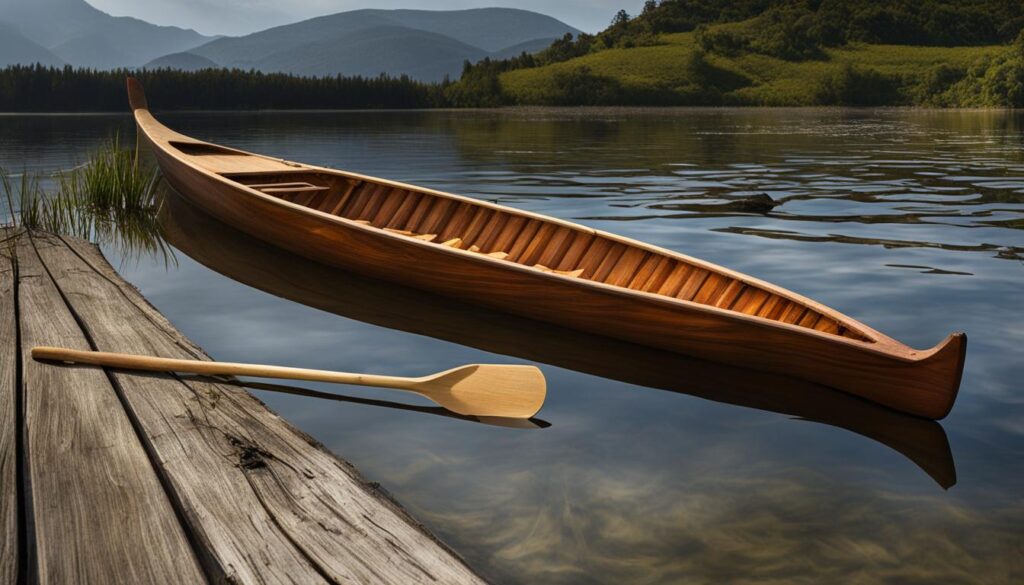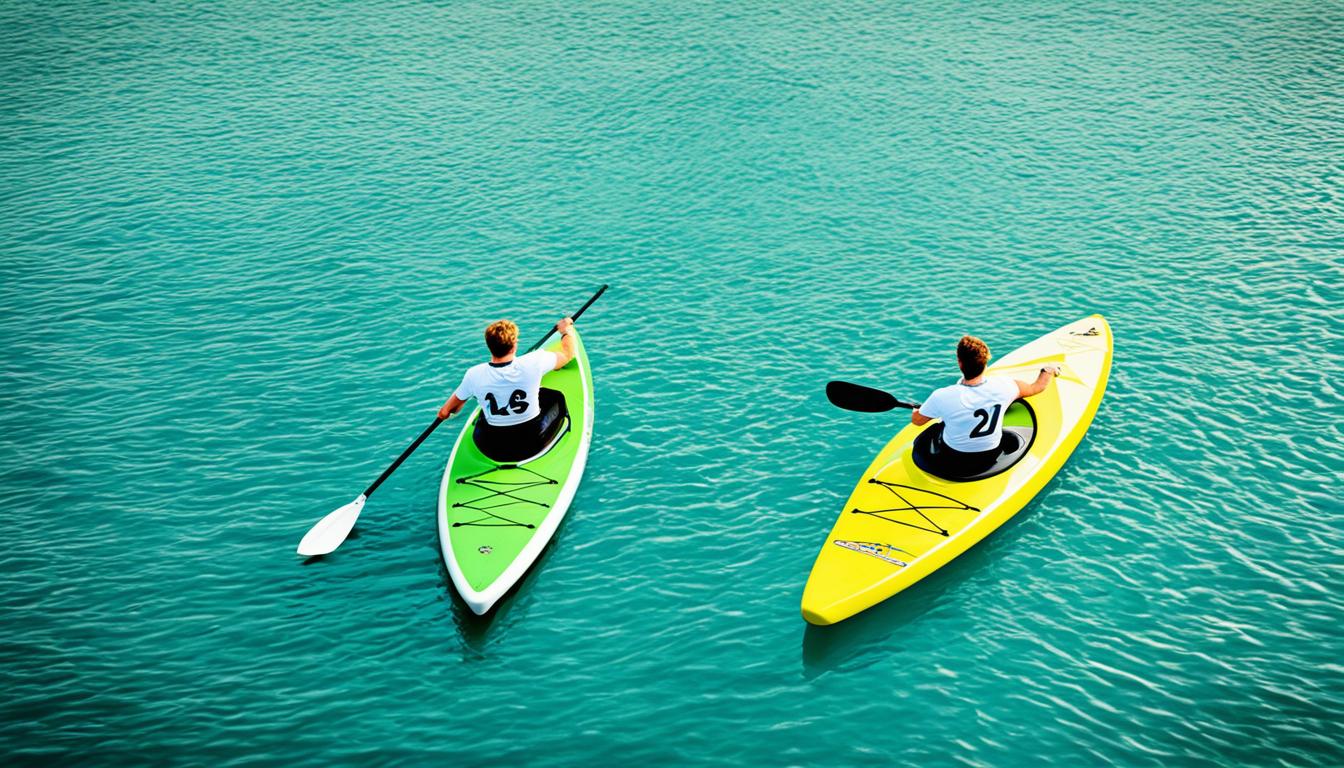When it comes to activities on the water, such as rowing, kayaking, or canoeing, the tools you use can greatly impact your experience. Two commonly confused tools are the paddle and the oar. While they may seem similar at first glance, there are several key differences between the two that are important to understand.
A paddle is a handheld tool used to propel a boat in the water. It consists of a long shaft and a blade at one or both ends. Paddles are commonly used in kayaking, canoeing, and stand-up paddleboarding (SUP). They are designed to be gripped in the middle of the shaft, allowing the user to apply force through a pulling or pushing motion.
On the other hand, an oar is a longer tool with a broader blade that is used for propelling and steering a boat. Unlike a paddle, oars are typically used in rowing, where they are fixed to the boat and manipulated through a pushing motion. Oars are commonly found on rowing shells and traditional rowboats.
Key Takeaways:
- Paddles are handheld tools used for pulling or pushing, while oars are fixed to the boat and manipulated through a pushing motion.
- Paddles are commonly used in kayaking, canoeing, and stand-up paddleboarding, while oars are used in rowing.
- The blades of paddles are shorter and broader, providing maneuverability, while oars have longer and narrower blades for efficiency and stability.
- Choosing the right tool depends on the activity and type of boat.
- Understanding the differences between paddles and oars will help optimize your water-based activities and enhance your overall enjoyment.
What is a Paddle?
A paddle is a handheld tool used to propel a boat in the water. It consists of a long shaft and a blade at one or both ends. Paddles are commonly used in kayaking, canoeing, and stand-up paddleboarding (SUP). They are designed to be gripped in the middle of the shaft, allowing the user to apply force through a pulling or pushing motion.

Paddles come in various shapes and sizes, depending on the type of watercraft and activity. Kayak paddles, for example, typically have two blades and a shorter shaft, while canoe paddles have a single blade and a slightly longer shaft. Stand-up paddleboard paddles are usually longer and adjustable in length to accommodate different paddling styles and water conditions.
When using a paddle, the technique may vary depending on the activity and personal preference. In kayaking, for instance, the paddler may use a high angle or a low angle stroke to optimize efficiency and maneuverability. Canoeing and stand-up paddleboarding also have their unique paddling techniques, which involve a combination of forward strokes, reverse strokes, and turning strokes.
“A paddle is a versatile tool that allows you to explore various water activities, from navigating whitewater rapids to leisurely cruising on calm lakes.”
Understanding the different types of paddles, their design characteristics, and how they are used can greatly enhance your experience on the water. Whether you’re an avid kayaker, a weekend canoeist, or a beginner stand-up paddleboarder, choosing the right paddle and mastering the proper techniques will significantly improve your performance and enjoyment of these exciting water sports.
| Paddle Type | Usage | Blade Shape | Shaft Length |
|---|---|---|---|
| Kayak Paddle | Kayaking | Double-bladed | Shorter |
| Canoe Paddle | Canoeing | Single-bladed | Slightly longer |
| Stand-Up Paddleboard Paddle | Stand-Up Paddleboarding (SUP) | Variable (depending on paddling style) | Adjustable |
What is an Oar?
An oar, on the other hand, is a longer tool with a broader blade that is used for propelling and steering a boat. Unlike a paddle, oars are typically used in rowing, where they are fixed to the boat and manipulated through a pushing motion. Oars are commonly found on rowing shells and traditional rowboats.
When it comes to rowing, oars play a vital role in providing the necessary leverage and control for the rower. The longer length and broader blade of an oar allow for more efficient propulsion and the ability to steer the boat effectively. This makes oars well-suited for activities that require precise navigation and power, such as competitive rowing.
Whether it’s a sleek rowing shell slicing through the water or a classic rowboat making its way along a tranquil lake, oars are the go-to choice for rowers seeking optimal performance. The fixed nature of oars allows rowers to generate power through a pushing motion, driving the boat forward with each stroke.
Many rowing enthusiasts appreciate the rhythmic nature of rowing and the sense of teamwork and synchronization it requires. Working in unison, a team of rowers can propel a boat through the water with remarkable speed and precision. The use of oars in rowing helps facilitate this coordination and enhances the overall rowing experience.
While oars are predominantly associated with rowing, they are also utilized in other applications, such as traditional rowboats used for leisurely outings or fishing. These boats rely on the power and steering capabilities provided by oars to navigate various water bodies.
Overall, oars are a fundamental tool for rowers and boat enthusiasts alike. Their unique design and functionality make them indispensable for activities that require precise control and propulsion, making them a sought-after choice for anyone looking to navigate the waters with ease.

| Comparison | Paddle | Oar |
|---|---|---|
| Usage | Handheld tool | Attached to the boat |
| Motion | Pulling or pushing | Pushing |
| Blade | Shorter and broader | Longer and narrower |
| Activity | Kayaking, canoeing, SUP | Rowing |
Key Differences between Paddles and Oars
While both paddles and oars serve the purpose of propelling a boat, there are several key differences between them.
Design and Usage:
Paddles are handheld tools that can be pulled or pushed through the water. They have a long shaft and a blade at one or both ends, designed for gripping in the middle. On the other hand, oars are longer and attached to the boat. They are manipulated through a pushing motion and are commonly used in rowing.
Blade Shape and Size:
Another significant difference lies in the shape and size of the blade. Paddles have shorter, broader blades that offer greater maneuverability in the water. This design allows for quick changes in direction and is well-suited for activities like kayaking and canoeing. Oars, on the other hand, have longer, narrower blades that prioritize efficiency and stability. This blade shape provides better leverage and control for rowers, making it suitable for rowing shells and traditional rowboats.
| Aspect | Paddles | Oars |
|---|---|---|
| Usage | Handheld for pulling or pushing | Attached to the boat, manipulated through a pushing motion |
| Blade Shape | Shorter, broader for maneuverability | Longer, narrower for efficiency and stability |
As seen in the table above, these key differences between paddles and oars highlight their distinct designs, purposes, and advantages. Whether you’re kayaking, canoeing, or rowing, understanding these differences will help you choose the right tool for your specific water activity.
Choosing the Right Tool for the Job
The choice between using a paddle or an oar depends on the activity and the type of boat you are using. For activities like kayaking, canoeing, and stand-up paddleboarding, a paddle is the preferred choice due to its maneuverability. Paddles are designed to offer better control and agility, allowing you to navigate through different water conditions and make quick turns with ease.
On the other hand, if you’re involved in rowing, whether for leisure or competition, oars are the appropriate choice. Oars provide rowers with greater leverage and control, enabling them to generate more power and maintain stability throughout the rowing stroke. The longer length and narrower blade of an oar are specifically designed to maximize efficiency and propulsive force when rowing.
Consider the specific requirements of your sport or leisure activity before deciding which tool is more suitable. If you enjoy exploring calm rivers or lakes in a kayak or canoe, or if you prefer the exhilaration of stand-up paddleboarding, a paddle is your best bet. On the other hand, if you’re passionate about rowing and want to improve your rowing efficiency and performance, oars are the way to go.
Always remember that choosing the right tool for the job can significantly enhance your experience on the water. It’s important to understand the differences between a paddle and an oar and select the one that aligns with your water activity goals and preferences. Whether you’re seeking maneuverability or power, the right tool will make all the difference in optimizing your performance and enjoyment.
Conclusion
In conclusion, understanding the differences between a paddle and an oar is crucial for optimizing your rowing, kayaking, or canoeing experience. Paddles and oars have distinct designs, functions, and usage, making them suitable for different types of boating activities. By choosing the right tool for the job, you can enhance your performance, maneuverability, and overall enjoyment on the water.
FAQ
What is the difference between a paddle and an oar?
The main difference between a paddle and an oar lies in their design, usage, and the activities they are commonly used for. A paddle is a handheld tool with a shaft and a blade, used for propelling boats such as kayaks, canoes, and stand-up paddleboards. An oar, on the other hand, is a longer tool with a broader blade, typically fixed to a boat and used for rowing and steering.
When should I use a paddle?
A paddle is the preferred tool for activities like kayaking, canoeing, and stand-up paddleboarding. Its design and grip allow for maneuverability and efficient propulsion through pulling or pushing motions. If you engage in these water activities, a paddle will provide better control and ease of use.
When should I use an oar?
Oars are primarily used for rowing activities, typically in rowboats or rowing shells. They are fixed to the boat and manipulated through a pushing motion. Oars offer better leverage and control, making them suitable for rowing sports or leisurely rowing in larger bodies of water.
What are the key differences in design between paddles and oars?
Paddles have shorter, broader blades compared to oars, which have longer, narrower blades. The broader blade of a paddle allows for better maneuverability, essential for activities like kayaking and canoeing. In contrast, the longer, narrower blade of an oar provides efficiency and stability, necessary for rowing sports.
How do I choose the right tool for my boating activity?
Choosing between a paddle and an oar depends on the specific boating activity and the type of boat you are using. If you engage in kayaking, canoeing, or stand-up paddleboarding, a paddle is the ideal choice due to its maneuverability. For rowing sports or leisurely rowing in a rowboat, an oar is the preferred tool for better leverage and control.
What are the benefits of using a paddle over an oar?
The benefits of using a paddle include enhanced maneuverability, ease of use, and better control in activities like kayaking, canoeing, and stand-up paddleboarding. Paddles allow for efficient propulsion through pulling or pushing motions, providing a more enjoyable and immersive experience on the water.

